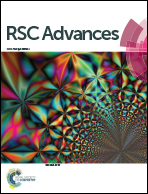Hydrothermal synthesis and electrochromism of WO3 nanocuboids
Abstract
Tungsten trioxide (WO3) nanocuboids are preferentially developed through control over three important processing parameters: fluoroboric acid concentration, hydrothermal reaction time and temperature. Fluoroboric acid concentration has significant influence on the phase transformation from triclinic to monoclinic followed by intermediate metastable hexagonal tungsten trioxide and simultaneous formation of thin plates to cuboid shapes. Optimum temperature and time are essential to achieve cuboid morphology without crystalline water molecules. Orthorhombic tungstite (H2WO4) grows from virgin precursors below 180 °C temperature prior to the formation of triclinic WO3. The monoclinic nanocuboid has average dimensions of 140 nm length, 120 nm width and 85 nm thickness but its surface area is reduced and its crystallinity is enhanced for times greater than the optimum reaction time. A probable hydrothermal assisted reaction has been proposed to justify the formation of morphology and phase selection. The band gap energy of WO3 insignificantly varies with respect to processing conditions, with the lowest at 2.75 eV. The current density of 3.15 mA cm−2 is attributed to the high-symmetry electrochemical reaction of the dip-coated nanocuboid WO3/ITO electrode. Coloration and bleaching kinetics depict the proton assisted-bleaching as faster than the coloration phenomenon with the appearance of 72.2% electrochromic reversibility. The fabricated nanocuboid WO3-coated ITO glass has fairly good optical transparency, electrochromic stability and reversibility.


 Please wait while we load your content...
Please wait while we load your content...